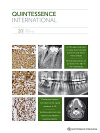The effect of television distraction versus Tell-Show-Do as behavioral management techniques in children undergoing dental treatments
Quintessence Int 51 (2020), No. 6 (20.05.2020)
Page 486-494, doi:10.3290/j.qi.a44366, PubMed:32253388
Objective: Distraction is a highly acceptable technique for diverting a
patient's attention from what may be perceived as an unpleasant
procedure, reducing anxiety and helping the patient relax. The objective
of the present study was to evaluate the effect of watching television
during dental treatment on pediatric patients' anxiety and cooperation
compared to the commonly used conventional Tell-Show-Do (TSD) behavioral
management method.Page 486-494, doi:10.3290/j.qi.a44366, PubMed:32253388
Method and materials: Sixty-nine children (mean age 6.8 years) scheduled to undergo restorative dental treatment were randomly divided into two intervention groups: a group that was managed by television distraction and a control group that was managed by TSD. During treatment, anxiety was assessed by the Facial Image Scale and cooperative behavior was assessed by the Frankl scale. Pulse rate and oxygen saturation were also measured during the treatment.
Results: Compared to TSD, television distraction significantly reduced anxiety by 1.27 (95% confidence interval [CI] 0.798 to 1.744, adjusted P < .001), decreased pulse rate by 6.44 beats per minute (bpm) (95% CI 4.60 to 8.28, adjusted P < .001), and significantly increased cooperation by 1.17 (95% CI −1.318 to −1.020, adjusted P < .001). A greater effect of television distraction on reduced anxiety and increased cooperation was observed during administration of the anesthetic injection. No effect of television distraction on saturation levels was noted.
Conclusions: Television distraction is an effective method for reducing anxiety and improving cooperative behavior in children during dental treatments.

Comments